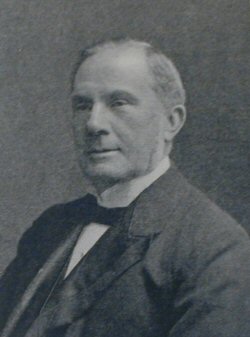 ROBERT
RATTRAY TATLOCK
ROBERT
RATTRAY TATLOCKPUBLIC Analyst, Gas Examiner and Sewage Chemist to Glasgow Corporation, Mr. Tatlock can claim a long hereditary connection with the city. In "The Chronicles of the Maltmen Craft," page 114, it is recorded that his maternal grandfather, "Robert Rattray, a Freeman, entered 11th May, 1827, as eldest son of John Rattray, a Freeman, entered 16th October, 1786, as eldest son of Alexander Rattray, a Freeman, entered 8th October, 1754, as eldest son of John Ratra, a Freeman, entered 21st August, 1702. as he who married Isobella Littlejohne, daughter of the deceist John Littlejohne, a Freeman, the date of whose entry is not given. He was son of William Littlejohne, a Freeman, entered 13th January, 1655, as son of James Littlejohne, maid Freeman Maltman, 24th September, 1631."
Mr. Tatlock himself was born in Glasgow, 18th May 1837. He received his early education at Greyfriars Church School, Glasgow, under Dr. Laing, and at the Trades' House School, under Mr. Thomas Struthers, who being himself an ardent student of natural science, imbued his scholar, at a comparatively early age, with a desire for the study of physical science. Mr. Tatlock afterwards studied chemistry systematically at Anderson's College, under Professor Penny, who succeeded Graham, Gregory, and Ure in the Chair of Chemistry there, and he was Penny's chief assistant for ten years, from 1857 to 1867. In this capacity he personally analysed all the productions, over a hundred in all, in the famous Pritchard trial. He was next engaged for a year as chemist at the works of the Kames Gunpowder Co., Kyles of Bute. In 1869 he commenced business in Glasgow as an analytical and consulting chemist, and was soon afterwards joined by Dr.William Wallace and Dr. John Clark. The firm of Wallace, Tatlock, and Clark existed for eighteen years. It then dissolved, and Mr. Tatlock assumed as partner Dr. James Readman, son of the late Mr. George Readman, manager of the Clydesdale Bank, and the firm of R. R. Tatlock and Readman subsisted for seven years. Then Mr. Tatlock's nephew, Mr. Robert Tatlock Thomson, who had been associated with him in business from the first, was assumed as a partner, and the style became R. R. Tatlock, Readman, & Thomson. On the retiral of Dr. Readman in 1895, the firm became R. R. Tatlock & Thomson, which is the present style.
During ten years, between 1873 and 1884, Mr. Tatlock filled the position of Lecturer on Chemistry at the College of Science and arts, now merged in the Glasgow and West of Scotland Technical College. He is author of numerous papers on scientific and chemico-technical subjects, embodying the results of much patient investigation, which have been published in various journals and magazines, including the Journal of the Society of Chemical Industry, the Analyst, and the Proceedings of the Royal Philosophical Society of Glasgow. He has had large experience as a chemical expert, over a wide and varied field, and in that capacity has been engaged in many causes célèbres. These include "Ballistite v. Cordite" - Nobel's Explosives Co. against H.M. Government; The S. African Gold Recovery Co. v. Infringers of the Macarthur-Forrest Cyanide Gold Extraction Patents, which was tried at the Transvaal High Court in Pretoria; The Welsbach Incandescent Gas Lighting Co. against Infringers of their Patents; and the "Enquiry" by the Transvaal Government into the cause of the explosion of 50 tons of dynamite at Johannesburg. During the last 40 years he has instructed in practical and theoretical chemistry a very large number of students, many of whom are now filling high positions all over the world. These include Sir William Ramsay, the discoverer of five new elements, and Lord Overtoun. A few years ago his former and present students and assistants presented him with his portrait, painted by the late William Stott, of Oldham, as a mark of their appreciation of the work of his life.
The subject of this sketch has served the City of Glasgow as a public analyst for 34 years, as gas examiner for 20 years, and as sewage chemist for 7 years. He is a Fellow of the Royal Society of Edinburgh, of the Institute of Chemistry of Great Britain and Ireland, and of the Chemical Society of London.